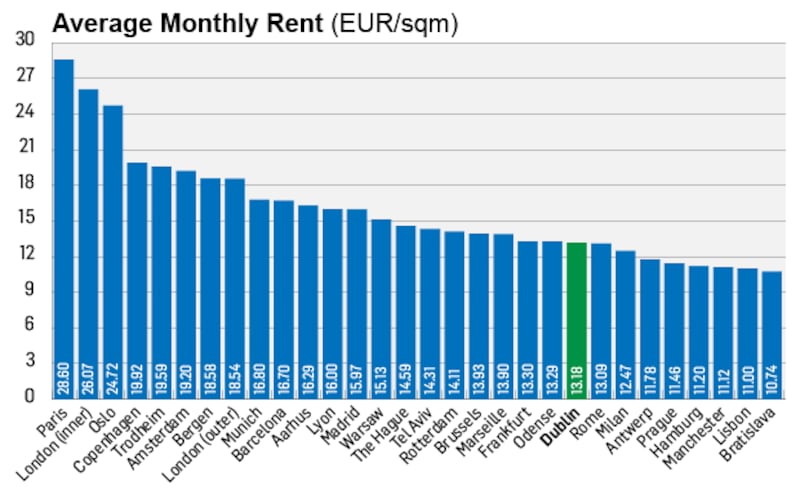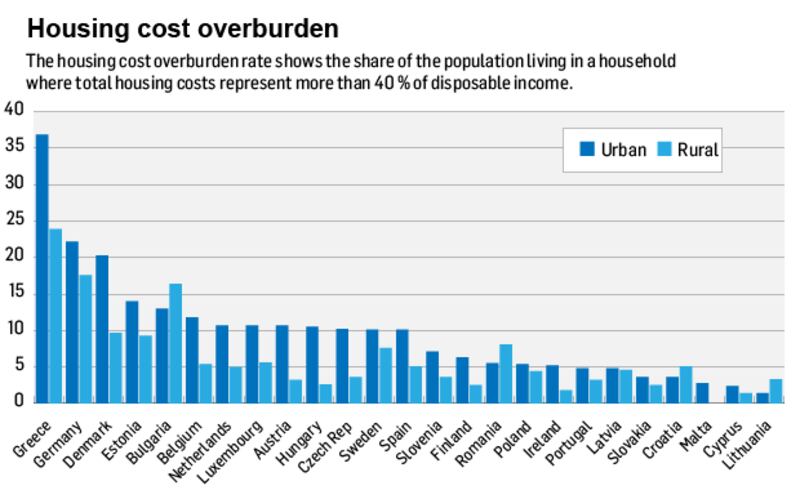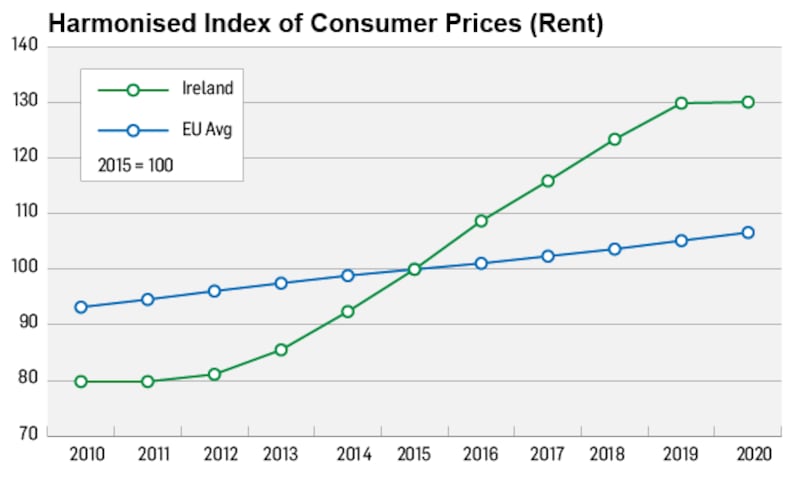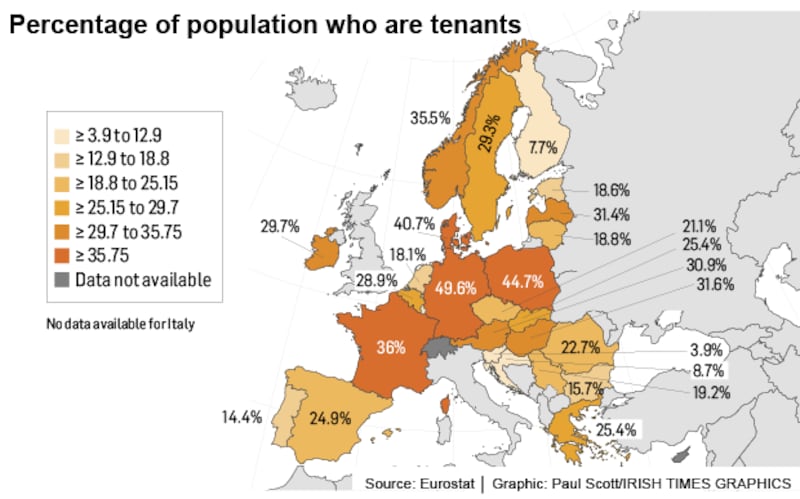Kim van Sparrentak was sharing her Rotterdam apartment with three flatmates as she campaigned for election to the European Parliament in 2019.
“When I got elected, I was still living with flatmates, and I was 29. I didn’t like – it was not my preferred option, so to say,” the Dutch Green MEP told The Irish Times. “I think my generation’s perspective has been quite present, at least in me, in looking at this issue.”
She went on to lead a report on “access to decent and affordable housing for all” that was adopted by the European Parliament earlier this year.
It highlighted rising rents, shortages in affordable housing and the greater and greater proportion of people in Europe that have become overburdened by housing costs, stating that “a growing number of low- and middle-income people living in the EU have difficulty affording housing”.

Across Europe, it’s a situation that has worsened since the global financial crisis, particularly for young people and the low paid, and particularly in cities. There is also a widening gap between renters and homeowners, whose mortgage costs have become comparatively cheaper than rent.
The International Monetary Fund predicts that Covid-19 will worsen the problem of affordable rents because the economic fallout of the pandemic disproportionately hit the professions of tenants. Jobs such as shop assistants, service workers, cleaners, food preparation and hospitality cannot be performed remotely and are disproportionately done by renters rather than homeowners. They are also the jobs of people who were on lower and less secure wages to begin with, particularly younger people and women.
“People thought that when Covid hit then maybe things would change, but it didn’t,” van Sparrentak said. “Everywhere, it’s just getting out of hand.”
If investors buy up these properties for high prices, in the end they want to make that back in rent. So they will try to increase the rent
Housing conditions across Europe are highly diverse from place to place, with different planning laws, local economic trends and social housing systems, among other factors. However, there are common trends.
A study by the International Monetary Fund found a variety of contributing factors to unaffordable rents, including tourism that brings a rise of short-term lets, increasing urbanisation as economic activity and the national population becomes concentrated in cities, and uneven economic growth that does not increase the wages of the lowest paid.
Some academics link rising costs to the increased use of housing as an investment, which together with the incentive of low interest rates has bid up house prices, in turn preventing many who would like to move out of the rental sector from becoming owners.
According to Dr Manuel Aalbers, an associate professor of human geography at the University of Leuven who leads a research project on the intersection of real estate, finance and states, it becomes a self-perpetuating cycle.
“If investors buy up these properties for high prices, in the end they want to make that back in rent. So they will try to increase the rent,” he said.

Young people are kept in the rental market for longer, splitting the rising costs with other adults in shared accommodation, causing rents to rise further. They are kept out of the housing market not just by high prices and an inability to save, but by the rise of insecure work contracts.
“If you want to get a mortgage, it’s not just about the level of your income, it’s about the stability of your income. If you make €1,500 one month and €4,000 the next, your average income might not be so bad comparatively speaking. But for a lender, this is not a guarantee to give someone a loan,” Dr Aalbers said.
A trend towards reducing tenant protections and deregulating investment, and assuming that markets would self-regulate and fix problems if left alone, set in as a cross-political and cross-country dominant assumption across Europe over recent decades, he added.
"Usually, further up north, rental regulations tend to be better. But in Sweden, like in the Netherlands, they have changed over time. They used to be great. Now, they're better than most, but not great anymore," Dr Aalbers said.
He disagrees that a free market model is appropriate for housing markets. “Because people have no option. You cannot retreat from the housing markets, you need to live somewhere,” he said.
The surge of support for Sinn Féin in Ireland's 2020 election... can be seen as part of a Europe-wide trend of housing crises that is driving upheaval in politics
Affordability problems became acute earlier in the countries most severely affected by the euro zone crisis, including Ireland, Portugal, Spain and Greece. However, they have spread across the EU, becoming severe in countries with less of a history of it and becoming a make-or-break political issue.
The Swedish government collapsed this summer when the prime minister Stefan Lofven lost a vote of confidence over a proposal to drop rent controls for tenants in newly built apartments. It reflected frustrations over years of failure to build sufficient rental housing, waiting lists for rental-controlled accommodation that averaged nine years in 2020, and widespread shortages pushing tenants into an expensive and insecure rental black market.
Also under pressure, neighbouring Denmark has proposed tripling the construction of subsidised housing in its four largest cities to address a cost crunch.
In the Netherlands, where house prices jumped a record 18.3 per cent in the year to October 2021, the newly formed Dutch government has announced it will have a designated housing minister charged with increasing the construction of affordable housing, with the aim of building 100,000 homes annually to ease the shortage.
"The Dutch population has been growing faster than the number of houses for some time, there has been quite a lot of pressure on [the] owner-occupied housing market as well as the liberalised rental housing," said Marcel Klok, a macroeconomist for the Netherlands with ING Bank.
“The Netherlands had quite a big housing crisis in the aftermath of the financial crisis – few new houses were being built and a lot of people left the construction sector,” he explained. Investors, domestic and foreign, have been piling into the housing market in recent years, but building has not kept up with demand.
“All political parties basically agree that we should construct more housing, but it takes time to really get that going.”
In a radical step, the citizens of Berlin voted in a city referendum in September to seize apartments from companies that own 3,000 units or more. There are 240,000 such flats, some 11 per cent of the city's stock.
The vote was not binding and may not pass legal muster, but was a kick in the rear to local and national government as a reaction to rising rents and landlord dominance in a city where most people are tenants.

The wholesale sell-off of social housing in Germany has given individual investment companies monopoly price-setting power in some neighbourhoods, according to Dr Aalbers. As an example of how large some landlords have become, he cites the German real estate company Vonovia, which has a property portfolio approaching half a million homes.
Spain’s left-wing government is seeking to impose rent controls and ban the sale of social housing to investment funds, while the city council of Czech capital Prague is planning to increase publicly owned housing, promote new-build affordable housing through co-operatives, and curb the renting of properties through Airbnb by higher taxation.
In this context, the surge of support for Sinn Féin in Ireland’s 2020 election, which was driven by younger and urban voters, can be seen as part of a Europe-wide trend of housing crises that is driving upheaval in politics across the continent.
Supporters of social housing argue that making it widely available... bids down rents for everyone while allowing public authorities to set high standards in housing
As national politicians have come under pressure, they have begun to seek European Union-level solutions to the housing problem.
Although housing policy is a matter for national and local governments, MEPs and some national leaders are challenging assumptions about how housing is treated at EU level, arguing that competition and debt rules can have a powerful influence on housing.
“For the longest time, the mantra has been that ‘housing is not a European competence’. But when you actually look at a lot of European policies, they do influence the housing goals, they do influence the housing market,” van Sparrentak told The Irish Times.
Portugal used its time in the rotating EU presidency this year to advocate for the adoption of "social rights" such as employment and quality of life as EU policy priorities. It culminated in a joint EU declaration to work to end homelessness by 2030 at a June summit on the issue in Lisbon, with commitments to stop evictions into homelessness and to use EU funds to prevent it.
In 2022, the Eurogroup club of finance ministers of euro-using countries will meet, with housing costs on its agenda for the first time.
"Suddenly it's not just Ireland, it's Vienna, its Copenhagen, it's Berlin," said Minister for Finance Paschal Donohoe, who chairs the Eurogroup as its president.
“They aren’t starting from the same point as Ireland, they don’t have the history of the same experience of recent years,” he added. “But all colleagues are experiencing the same thing.”
He suggested as common factors: the large savings that many households built up during the pandemic when commuting and entertainment costs were put on ice, pressure on prices as construction work and the demand for builders recommenced all at the same time, and people looking for different things in housing, such as more space.
As solutions to tackle high housing costs, studies suggest increasing the supply of affordable housing, punishing those who keep properties empty with taxes (some advocate the more radical approach of decriminalising squatting) and ensuring that people on lower incomes share in economic growth.
Van Sparrentak's affordable housing report called for the reform of EU borrow-and-spend rules to enable more investment in social housing. It also called for a change in mindset at the European Commission: to abandon the idea that social housing affects competition in the housing market, and no longer narrowly define such accommodation as being targeted for socially disadvantaged citizens.

Supporters of social housing argue that making it widely available – including for higher earners – bids down rents for everyone while allowing public authorities to set high standards in housing, part of growing demands for increased state intervention in housing markets.
"Unfortunately, we have now done an experiment with the housing market. We got all these vulture funds and big investors in and said: okay, you fix the housing market for us," van Sparrentak said. "And where are we now? We have doubled homelessness and more and more people are not able to afford their homes."
****
How does Ireland differ?
Perhaps contrary to popular perception, Ireland does not stick out for high home ownership rates in Europe and has a mid-to-high proportion of renters – at 31.3 per cent tenants versus 68.7 per cent owner-occupied – according to EU data. Only eight countries have a higher percentage of renters, most notably Austria and Germany which are close to half-and-half homeowners and tenants.
In most countries and on average across the EU overall, house prices have risen more than rents over the last decade. But Ireland bucks this trend: rents have risen more than 60 per cent in that time while houses are up 30 percent according to Eurostat. In Estonia, Finland and Romania, rents have also outstripped housing; perhaps most dramatically in Lithuania, where rents have more than doubled in a decade while house prices are up more than 80 per cent.
There are five European countries in which social housing makes up close to or more than 20 percent of all housing stock: the Netherlands, Denmark, Austria, France and the United Kingdom. Ireland is mid range, with 8.7 per cent social housing according to OECD figures, not a frontrunner but double the likes of Germany and Hungary and far above Luxembourg, Estonia, the Czech Republic and Latvia, which are all 1.6 per cent or less. Whatever the level of social housing, it tends to be oversubscribed. Waiting lists are years long, even in the Netherlands where social housing accounts for 34 per cent of total housing stock.
Ireland was an early forerunner in some housing trends that are now emerging elsewhere, such as a shortage of construction workers and housing supply
In OECD figures, Ireland sticks out for the proportion of about 30 per cent of social housing that is provided by the private sector (rent is paid directly to private landlords under the Housing Assistance Payment, a practice that has been criticised for setting a floor under rent levels).
Slovenia, the Netherlands and Estonia also have a proportion of privately provided social housing, but on the whole it's an unusual practice. Social housing is more commonly provided directly by local and national authorities, public agencies, non-profit providers and co-operatives.
Ireland also has less inequality in how the burden of rent affects households. An OECD paper based on 2019 data showed that in almost every country studied, the poorest households had the greatest burden in rent, paying more than 40 per cent of their disposable income on it in the United Kingdom, Greece, Sweden, Luxembourg, Switzerland and Finland.
In Ireland, uniquely among the countries studied, this trend was flipped, with middle-income households paying a larger proportion on rent than the poorest. Overall in Ireland rent burdens were towards the lower end of the scale among the countries studied, at about 20 per cent of disposable income.
Households are deemed “overburdened” in EU figures if they spend more than 40 per cent of their disposable income on housing costs. In Ireland in 2020, 5.2 per cent of households in cities were overburdened by this measure and 1.8 per cent in rural areas, according to Eurostat figures. This is a comparatively low rate in the EU, particularly for northwestern Europe; Portugal is the only western European country to have a lower rate.
However, the difference between urban and rural areas in the rate of overburdened people is particularly sharp in Ireland. Dublin has had a particularly pronounced case of rents rising far faster than across the country as a whole. Rents rose in the capital by almost 60 per cent between 2013 and 2018 at a time when national rents rose by a fraction of that, according to an IMF study. Only Lisbon had a more dramatic experience as its rents more than doubled, even as Portugal as a whole saw a single-digit rent rise.
Ireland was an early forerunner in some housing trends that are now emerging elsewhere, such as a shortage of construction workers and housing supply to keep up with population growth, and the dominance of institutional investment in driving money into the housing market.










